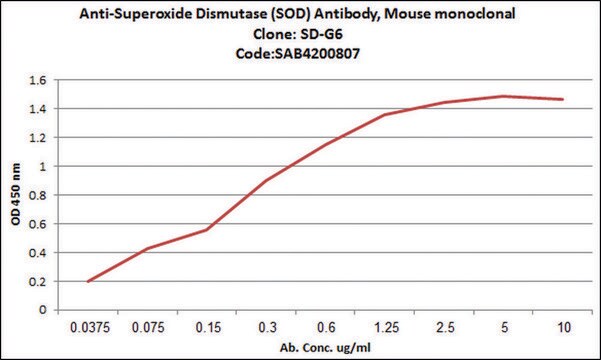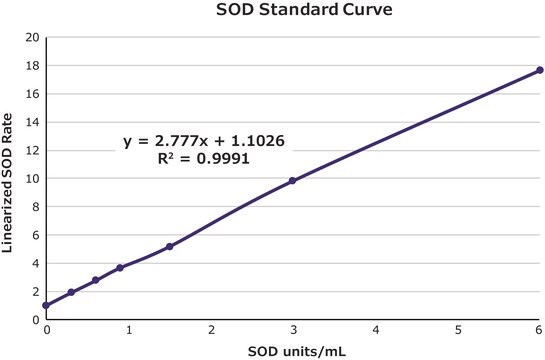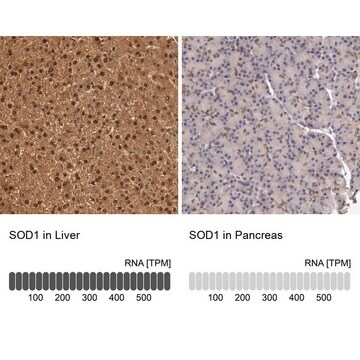推薦產品
生物源
mouse
品質等級
共軛
unconjugated
抗體表格
ascites fluid
抗體產品種類
primary antibodies
無性繁殖
SD-G6, monoclonal
包含
15 mM sodium azide
物種活性
canine, human, rat
技術
indirect ELISA: 1:300
同型
IgG1
UniProt登錄號
運輸包裝
dry ice
儲存溫度
−20°C
目標翻譯後修改
unmodified
基因資訊
human ... SOD1(6647)
rat ... Sod1(24786)
一般說明
Monoclonal Anti-Superoxide Dismutase (mouse IgG1 isotype) is derived from the hybridoma produced by the fusion of mouse myeloma cells and splenocytes from an immunized mouse. Superoxide Dismutase (SOD) is a family of metalloenzymes widely distributed in both plants and animals. In mammalian tissues, three types of superoxide dismutase [Cu-Zn-SOD, Mn-SOD, extracellular (EC)-SOD] occur. Human manganese superoxide dismutase (MnSOD), isolated from liver is composed of 22 kDa subunits each containing one Mn atom, while SOD from bovine erythrocyte has a molecular weight of 32.5 kDa. Superoxide Dismutase occurs in high concentrations in brain, liver, heart, erythrocytes and kidney.
Superoxide Dismutase (SOD) or CuZn-SOD (SOD1), a cytoplasmic and mitochondrial intermembrane space protein is located on human chromosome 21q22. It belongs to superoxide dismutase multigene family.
特異性
The antibody recognizes natural and recombinant human-Cu-Zn-SOD, human placental SOD, and human erythrocyte SOD using direct capture or competitive ELISA. Cross-reactivity has been observed with human liver and salivary gland, rat salivary gland, pheochromocytoma cell line (PC12), and dog salivary gland. No reactivity was observed with SOD from bovine erythrocytes, kidney, and liver; dog erythrocytes; Bacillus stearothermophilus; E. coli, or horseradish.
免疫原
recombinant human copper-zinc superoxide dismutase (Cu-Zn-SOD).
應用
Anti-Superoxide Dismutase (SOD) antibody has been used in immunohistochemistry and Cu-Zn SOD detection via ELISA.
生化/生理作用
Superoxide Dismutase (SOD) appear to protect cells against reactive free radicals by scavenging the superoxide radicals produced by ionization radiation or through other mechanisms. SOD have been proposed as clinically useful for a wide variety of applications including prevention of oncogenesis, tumor promotion, tumor invasiveness, radiation damage, reduction of the cytotoxic and cardiotoxic effects of anticancer drugs, as a measure against the aging process and as anti-inflammatory agents.
Superoxide Dismutase (SOD) or CuZn-SOD (SOD1) mutations results in amyotrophic lateral sclerosis It acts as a mediator of the HMF (hypomagnetic field) effect.
免責聲明
Unless otherwise stated in our catalog or other company documentation accompanying the product(s), our products are intended for research use only and are not to be used for any other purpose, which includes but is not limited to, unauthorized commercial uses, in vitro diagnostic uses, ex vivo or in vivo therapeutic uses or any type of consumption or application to humans or animals.
未找到適合的產品?
試用我們的產品選擇工具.
儲存類別代碼
10 - Combustible liquids
水污染物質分類(WGK)
WGK 3
閃點(°F)
Not applicable
閃點(°C)
Not applicable
Reactive oxygen species (ROS) and response of antioxidants as ROS-scavengers during environmental stress in plants
Das K, et al.
Frontiers in environmental science., 2 (2014)
Formation of high molecular weight complexes of mutant Cu, Zn-superoxide dismutase in a mouse model for familial amyotrophic lateral sclerosis
Johnston JA, et al.
Proceedings of the National Academy of Sciences of the USA, 97(23), 12571-12576 (2000)
Superoxide dismutase multigene family: a comparison of the CuZn-SOD (SOD1), Mn-SOD (SOD2), and EC-SOD (SOD3) gene structures, evolution, and expression
Zelko IN, et al.
Free Radical Biology & Medicine, 33(3), 337-349 (2002)
J A Johnston et al.
Proceedings of the National Academy of Sciences of the United States of America, 97(23), 12571-12576 (2000-10-26)
Deposition of aggregated protein into neurofilament-rich cytoplasmic inclusion bodies is a common cytopathological feature of neurodegenerative disease. How-or indeed whether-protein aggregation and inclusion body formation cause neurotoxicity are presently unknown. Here, we show that the capacity of superoxide dismutase (SOD)
Marcel Maier et al.
Science translational medicine, 10(470) (2018-12-07)
Mutations in the gene encoding superoxide dismutase 1 (SOD1) lead to misfolding and aggregation of SOD1 and cause familial amyotrophic lateral sclerosis (FALS). However, the implications of wild-type SOD1 misfolding in sporadic forms of ALS (SALS) remain unclear. By screening
我們的科學家團隊在所有研究領域都有豐富的經驗,包括生命科學、材料科學、化學合成、色譜、分析等.
聯絡技術服務



